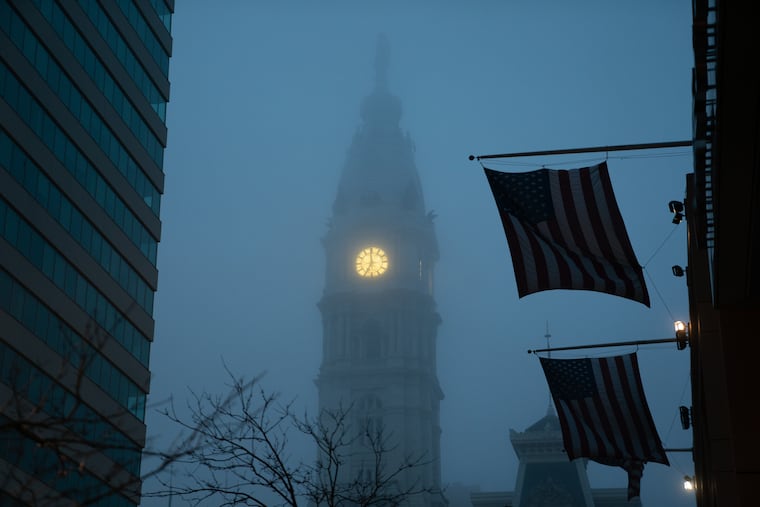Even as COVID-19 continues, a doctor’s gratitude for how far we’ve come | Expert Opinion
COVID-19 is not going away any time soon, and even the most concerted efforts will not keep this virus out of our lives completely. But we should acknowledge what we've learned and done.

On a chilly November night, I walked through City Hall and took a moment to read the plaque of William Penn’s “Prayer for Philadelphia,” the words perfectly suited for a city under siege for 20 months.
“And Thou, Philadelphia, the virgin settlement of this province — named before thou wert born. What love, what care, what service and what travail, there have been to bring thee forth and to preserve thee from such as would abuse and defile thee.”
The abuser and defiler, in this case, is COVID-19. Penn’s words trigger a question: How successful has this city been in keeping its 1.6 million citizens safe?
What I find surprises even me. There are 67 counties in Pennsylvania, and as of the week of Nov. 21, according to data in the New York Times, Philadelphia has the lowest seven-day case rate of COVID-19 in the commonwealth, at 17 per 100,000 people. The average case rate across the state is 49. Some counties have rates as high as 132 per 100,000.
These facts are worth noting. Despite having the highest population density, which is a risk factor for the spread of the virus, Philadelphia is currently the biggest success story in the commonwealth. Its case rate also is lower than any county in neighboring New Jersey and Delaware.
Nothing about this virus can be ascribed to luck or chance. We know too much about how it moves around, how to test for it, and how to treat it for luck to be a factor this deep into the pandemic — so something that is happening in Philadelphia is not happening in other parts of the state.
First, the city’s institutions stepped up quickly. In March 2020, the city implemented an immediate lockdown. Masks became mandatory indoors and outdoors. Later, with appropriate guidance from the Department of Public Health, shops were allowed to open with reasonable precautions.
Our medical institutions also wasted no time in responding to the pandemic. Here at Jefferson Hospital, all lung doctors and others were pulled from their clinics and placed on an emergency schedule. I am told the same thing happened at the University of Pennsylvania and Temple Hospitals. Doctors who hadn’t done overnight shifts in decades were bunking down in uncomfortable on-call rooms. Physician assistants and nurse practitioners selflessly filled the gaps in the clinic.
Most importantly, the hospitals quickly ramped up capacity for testing, as neither state nor private labs had the capacity to test in the numbers needed to bend the curve of infections.
A typical Philadelphia story of taking matters into one’s own hands is that of Ala Stanford. A pediatric surgeon, she saw a huge gap in the rate at which Black Philadelphians were getting tested. She rented a van, gathered volunteers and supplies, and began testing people. This project has provided testing and vaccinations to 75,000 people.
» READ MORE: This doctor deserves a standing ovation for her swift response to the coronavirus crisis | Jenice Armstrong
I will never forget the way, at the beginning of the pandemic, all types of health-care workers fearlessly went into rooms rife with virus to take care of patients. Seeing their bravery gave me the courage to go into the rooms myself.
The citizens of Philadelphia have been right there as well, heeding the call to wear masks, to socially distance, and to take reasonable precautions. And the city’s essential workers have from day one continued to show up to work to keep things running.
Philadelphia’s comparative success has been no accident. A tremendous amount of work, sacrifice, and goodwill has made it possible; today, the virus is under reasonable control, the city is up and running, and our hospitals are not currently overwhelmed.
Sadly, case numbers are now increasing throughout the country and the state. This is predictable given the suboptimal vaccination rates and a virus that continues to mutate into something that is more contagious.
COVID-19 is not going away any time soon, and even the most concerted efforts will not keep this virus out of our lives completely. One area where Philadelphia could do better is in our overall vaccination rate for residents 12 and older, which stands at 68%.
This would be the best tribute to Philadelphia and to the people here who have helped us achieve a record worth being proud of. This leads us to the ending of the prayer, a fitting lead-in to this holiday season.
“Oh that thou mayest be kept from the evil that would overwhelm thee; that faithful to the God of the Mercies, in the life of righteousness, thou mayest be preserved to the end.”
Michael J. Stephen is an associate professor of medicine at Thomas Jefferson University and head of the Adult Cystic Fibrosis Center. You can read more about him at drmichaelstephen.com.